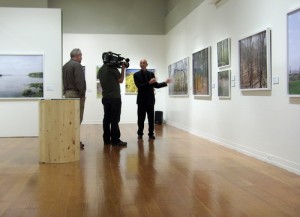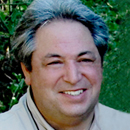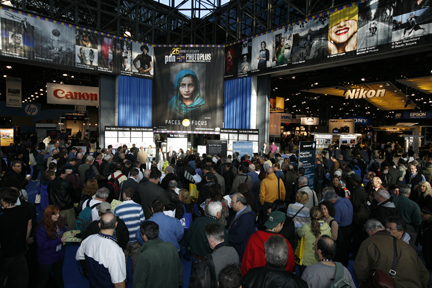By Eileen Fritsch
Editor, LexJet’s In Focus Newsletter
When I attend photo-industry trade shows for LexJet, I look for new ideas, trends, products, and services that can help professional photographers do more with their wide-format inkjet printers. So I always like to see how the “big-three” printer manufacturers are promoting their products. Last week, I talked about some of Epson’s educational activities related to PDN PhotoPlus Expo (PPE) in New York in October.

Today, I want to talk about an exceptional panel discussion that HP organized at PPE to show how photojournalists are redefining themselves now that fewer publications are hiring them for assignments. Entitled New Ideas, New Beginnings, the panel discussion was moderated by Harald Johnson, who wrote the groundbreaking book Mastering Digital Printing.
The panelists included Magnum photographers Thomas Hoepker and Joel Meyerowitz (who are using HP Designjet Z3200 wide-format printers to make their own exhibition prints) and Eileen Gittins, the enterprising photography enthusiast who founded Blurb (which uses HP Indigo digital presses to print hundreds of thousands photo books a year, in quantities as small as one book at a time).
Thomas Hoepker started out by talking about how difficult it has become to make money in stock photography—particularly now that Corbis has a collection of 100 million images, Getty has 60 million images, and iStock Photo has roughly 1.8 million contributors. The good news, he said, is that digital imaging allows photographers to do more things for themselves, such as printing their own exhibitions and collector prints. He said he never really planned to get into fine-art photography or making his own prints. But after he developed a retrospective exhibition of his 40+ year career in photojournalism, he started getting calls from collectors.
Until then, Hoepker had only been using dye-based printers for proofs and comps. But now he uses the HP Designjet Z3200 wide-format inkjet printer to produce the pigment-ink prints he sells to collectors for thousands of dollars each. Like others at the PPE show, Hoepker said inkjet printing has become straightforward enough that you don’t have to become a printing geek to get exhibition-worthy results. He believes that because of the explosion of images online, there is a newfound appreciation for printed images, especially big prints.

Next up was Joel Meyerowitz, who talked about how he used an HP Designjet Z3200 to print all 75 of the 40 x 50-in. and 30 x 40 in. images displayed in his new exhibition at the Museum of the City of New York. Entitled Legacy: The Preservation of Wilderness in New York City Parks, the exhibition displays the best of the 3,000 images Meyerowitz shot during three-year project to document the remaining pockets of “wilderness” in the 29,000 acres of parks in New York’s five boroughs.
To give exhibition visitors the sense they are entering the natural world in New York, some of Meyerowitz’s images of trees and rivers were printed as big as 9 x 12 ft. using HP’s new Designjet L65500 latex-ink printer. These oversized prints were installed as “immersive graphics” on the walls and floors of the exhibition’s entryway. Meyerowitz said he was skeptical at first at how well his images would look when output on a printer used for commercial graphics, but said he was pleasantly surprised by the quality.
Along with the exhibition prints, Meyerowitz worked with the Aperture Foundation to produce a limited-edition boxed set that includes a coffeetable book about the Legacy project, a limited-edition book about the Hallett Nature Sanctuary in Central Park printed on an HP Indigo 5500 digital press, and a pigment-ink print output on an HP Designjet Z3200. Each print and limited-edition book is numbered and signed by Meyerowitz. The collector’s “boxed set” represents a new concept for selling art prints in conjunction with photo books.
Meyerowitz’s boxed set used a concept similar to the one introduced by the three artists of the Digital Atelier in HP’s booth at the Print 09 show. The Digital Atelier boxed set combined a book about their pioneering work in digital printmaking, along with limited-edition prints that had been produced with a variety of HP’s aqueous, solvent, and UV-curable ink printing technologies.
The final panelist was Eileen Gittins who said when she founded Blurb in 2001 she envisioned it primarily as a way for consumers to print small quantities of professional-looking photo books. Since then, Blurb has become extremely popular with professional photographers. She said many pro photographers are using books not only as portfolio books, but also to promote their work with fan clubs and social causes. For example, if you use social networking to build a community of fans for your photography, you can publish a Blurb book and sell it through your own blog and website. Blurb lets you set your own price for a book and keep all of the profits.
Photographers who serve as the official photographer for special events often publish books and sell them on Blurb. Gittins says this can be a great way for young photographers to gain national exposure and attract their “natural audience”—people who are enthusiastic and passionate about the same subjects and causes they are. Some photographers are gaining nationwide recognition by creating photo books to promote a cause, then donating the proceeds to charity.
After the presentation was over, it was clear that the panelists had succeeded in encouraging the audience to thnk differently. The panelists had conveyed two important messages:
- Just because today’s markets for professional photography aren’t the same as they once were doesn’t mean that there aren’t real opportunities to build a career for yourself as a photographer.
- Now that digital printing technologies have replicated (or exceeded) the printing methods used in the past, the time has come to start exploring how digital-printing technologies can be used to do create photo products and presentations that were never practical before.
Note that if the idea of creating immersive graphics for your next photo exhibition intrigues you, call one of the account specialists at LexJet at 800-453-9538.
In addition to teaching pro photographers how to print their own work, the tech-support team at LexJet has taught literally thousands of photo labs and printing businesses how to use their wide-format inkjet printers to create all types of graphics, including wall murals, floor graphics and window graphics. If you’d rather not make big graphics yourself, we can refer you to printing companies in your area that can.






